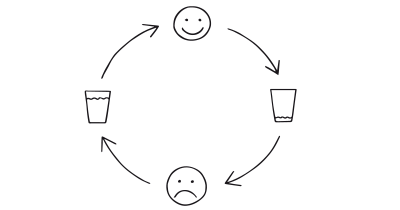Persuasive Patterns: Influence
Kairos
Communicate to users in situations that are the opportune moments for change

Kairos refers to the strategic art of timing, specifically communicating or acting at the most opportune moment for maximum impact.
Imagine that you recently decided to focus on your fitness. You start by setting a goal to run every morning. Initially, you are enthusiastic, but as days pass, your motivation wanes. One morning, you wake up to a message from a friend inviting you to join a virtual running challenge. The timing of this invitation is perfect – just when your preceding motivation was at its lowest. This external prompt at a crucial moment rekindles your commitment to your fitness goal.
Now, consider a fitness app that you use, designed to recognize patterns in user activity. After a few days of inactivity, the app sends you a personalized notification, reminding you of your progress and the benefits of staying active. The message arrives at a time when you are contemplating whether to resume your running routine. This timely intervention, much like the invitation from a friend, serves as a crucial nudge, leveraging the principle of Kairos – communicating at the opportune moment to encourage you to re-engage with your fitness goals.
The study
One influential study in the realm of Kairos is Fogg’s Behavior Model, which posits that behavior change occurs when three elements converge at the same moment: motivation, ability, and a prompt. This model, fundamental to understanding Kairos, illustrates how timing is crucial in triggering a desired behavior.
Fogg’s research demonstrated that even if motivation and ability are present, without a timely prompt, the desired behavior is unlikely to occur.
Fogg, B. J. (2009). A behavior model for persuasive design. Proceedings of the 4th International Conference on Persuasive Technology - Persuasive ‘09.
Kairos is a persuasive technique that emphasizes the importance of context and timing in delivering messages or prompting actions. It involves identifying and capitalizing on critical moments when a user is most receptive to influence, leading to more effective decision-making, behavior change, or engagement with a product or service.
Aristotle’s Kairos
The psychological principle of Kairos, as outlined by Aristotle, is deeply rooted in the art of rhetoric and persuasion. Kairos is an ancient Greek word meaning the right, critical, or opportune moment. Aristotle’s concept of Kairos refers to the ability to recognize and take advantage of the precise moment in time when an action or speech would be most effective.
For Aristotle, Kairos was about understanding the context and environment to ascertain the most opportune time to deliver a message or take action. It is not just about what is said or done, but when it is said or done.
This principle underscores the importance of adaptability and sensitivity to the changing dynamics of a situation. It involves an acute awareness of the audience, the environment, and the evolving circumstances to identify the most impactful moment for communication or action.
In rhetoric, Kairos plays a crucial role in the effectiveness of persuasion. It’s about delivering the right message at the right time to the right audience. This could mean capitalizing on a particular mood, event, or set of circumstances that makes the audience more receptive to the message.
Kairos is also about understanding the emotional and intellectual state of the audience. A message delivered too early or too late may lose its potency or relevance.
Aristotle also considered the ethical dimensions of Kairos. He argued that understanding and utilizing the opportune moment should be balanced with ethical considerations. The speaker or actor must not only seize the moment but also respect the audience’s needs and context.
This aspect of Kairos emphasizes the responsibility of the communicator to consider the implications and consequences of their actions or words.
Kairos is closely linked with other rhetorical elements such as ethos (credibility), pathos (emotional appeal), and logos (logical argument). The successful integration of these elements with a keen sense of timing can lead to persuasive and impactful communication.
Timing in modern psychology and communication
In contemporary psychology and communication, the concept of Kairos remains relevant, particularly in fields like marketing, therapy, education, and leadership. It’s about recognizing and creating moments of significant impact, whether in a therapeutic session, a classroom, a marketing campaign, or a leadership decision.
The application of Kairos extends to digital design and user experience, where understanding the user’s context and delivering content or prompts at just the right moment can greatly enhance engagement and effectiveness.
The principle of Kairos is about the strategic timing of messages or interventions to coincide with moments when individuals are most receptive to influence or change. This is based on the understanding that people’s willingness to engage, learn, or change behavior is not static but fluctuates based on a variety of factors, including emotional state, environment, and readiness for change.
Individuals move through different stages of readiness for change - from precontemplation to contemplation, preparation, action, and maintenance. Kairos in design targets these stages effectively by delivering prompts or information at the right stage to facilitate movement to the next stage.
People’s decision-making processes are highly influenced by their current emotional and cognitive states. For instance, someone who is stressed or distracted may not be receptive to complex or challenging information. Kairos involves understanding and leveraging these states, providing information or prompts when the user is in the best state to receive them.
The context in which a decision is made can greatly influence the outcome. Behavioral economics, a field that merges economic analysis with psychological insights into human behavior, often studies how context and framing of choices impact decision-making. The principle of Kairos considers the user’s context to time interventions for maximum effectiveness.
The concept of situational triggers, which are cues in an individual’s environment that prompt a specific behavior, is also central to Kairos. These triggers can be optimally timed to coincide with moments when a person is most likely to take a desired action.
Understanding what motivates people at different times allows for the creation of tailored messages or prompts that resonate more effectively with the individual’s current needs, desires, or challenges.
Designing products with Kairos
Kairos, representing the perfect moment for action or decision, can significantly enhance user experience when applied thoughtfully in design. Below are practical tips for how you can integrate the principle of Kairos effectively.
First and foremost, it’s crucial to develop a deep understanding of the user’s journey and context. This involves researching and identifying moments when the user is most open to receiving a message, trying a new feature, or making a decision. It could be a specific time of the day, a particular day of the week, or a stage in the user’s life or professional cycle. For instance, a financial app might target users with investment options at the end of the month, when they are likely reflecting on their finances.
As you investigate when to prompt users to conduct a target behavior, go through each relevant step in the user’s journey and score the user’s receptiveness toward conducting that behavior at the time of each step. According to BJ Fogg’s Behavior Model, two critical factors must be examined: the user’s motivation to engage in the behavior and their ability (how easy it is to conduct) in the given moment. Continue the examination by identifying potential barriers (ability) and enablers (motivation) of the behavior.
Enrigh the user journey map by analyzing data to pinpoint when users are most active or likely to engage with your product. A data-driven approach can reveal patterns and optimal timings for introducing new features, sending notifications, or prompting users to take action. A fitness app, for example, might nudge users to exercise based on their previous workout times, thereby capitalizing on established routines.
Tailoring content and interactions to the individual user is another critical aspect of Kairos in design. This might mean suggesting a playlist in a music app when the user typically listens to music or offering a restock prompt in a shopping app when supplies are likely running low.
Predictive design elements that anticipate the user’s needs before they even express them can proactively help change behaviors. For example, a project management tool might suggest task templates or automation options when it detects a user setting up a repetitive task.
Craft messages and prompts that create a sense of urgency or relevance at the right moment. This could involve highlighting limited-time offers or stressing the immediate benefits of a particular action.
Ethical recommendations
One primary ethical concern when designing for opportune moments is the exploitation of vulnerable moments. For example, targeting users with persuasive messages during moments of emotional vulnerability could lead to decisions that they might not make under normal circumstances. Additionally, there’s a risk of manipulation, where the pattern is used to push agendas or products in a way that prioritizes business goals over user well-being.
Presenting information in a way that exaggerates benefits or downplays risks during these opportune moments can lead to users making poorly informed decisions. For instance to trigger impulsive actions, like pushing for immediate sign-ups or purchases without giving users time to consider their choices thoroughly.
To ensure that Kairos is used ethically and remains user-centric, the following best practices are recommended:
- Prioritize user well-being
Always consider the impact of your design on the user’s mental and emotional state. Ensure that any action encouraged is in the user’s best interest. - Be transparent
Be clear about your intentions and the nature of the content or suggestions presented to users. Avoid hidden motives or misleading information. - Respect user autonomy
While Kairos involves seizing key moments, it should not take away the user’s sense of control or choice. Offer options and allow users to make informed decisions. - Avoid Pressure Tactics
Refrain from creating unnecessary urgency or pressure. Allow users enough space and time to make decisions at their own pace. - Sensitive timing
Be cautious about the timing of your messages. Avoid targeting users during times of high vulnerability or stress.
Real life Kairos examples
Nike
Nike often launches marketing campaigns around New Year’s, a time when many people are setting fitness goals. By aligning their marketing messages with this period of heightened motivation for self-improvement, Nike effectively uses Kairos to promote their fitness apparel and gear.
Spotify
Spotify capitalizes on the festive season by offering personalized playlists during holidays like Christmas or Halloween. By aligning with users’ emotional state during these times, Spotify uses Kairos to enhance user engagement.
Starbucks
Starbucks releases seasonal drinks like Pumpkin Spice Lattes in autumn, capitalizing on the seasonal mood and customer preferences. This timing not only aligns with customer cravings for seasonal flavors but also creates a buzz and increases sales during specific times of the year.
Trigger Questions
- What are our users' typical contexts when they engage with our product?
- How can we align our interactions with the emotional state of our users?
- At what point in the user journey is our message most relevant?
- Are there specific events or times when our product becomes more relevant to the user?
- How can we ensure our timing enhances the user experience rather than disrupting it?
- What feedback do we have about our users' reactions to our timing, and how can we adapt accordingly?
- How can we leverage data and user insights to pinpoint optimal timing for our messages or prompts?
- In what ways can we personalize our approach to resonate with individual user preferences and habits?
- What predictive elements can we introduce to anticipate and meet user needs proactively?
- How can we create a sense of urgency or relevance without overwhelming the user?
Pairings
Kairos + Social Proof
Combining Kairos with social proof can be powerful. For instance, a fitness app might highlight a community challenge at the beginning of the new year, capitalizing on the common resolution to get fit. The timing (Kairos) combined with the influence of community participation (Social Proof) can significantly motivate users.

Communicate to users in situations that are the opportune moments for change

We assume the actions of others in new or unfamiliar situations
Kairos + Loss Aversion
This combination works well in financial apps. Offering special investment opportunities during market dips can leverage the fear of missing out (Loss Aversion) at the optimal moment (Kairos).

Communicate to users in situations that are the opportune moments for change

Our fear of losing motivates us more than the prospect of gaining
Kairos + Scarcity Bias
In e-commerce, presenting limited-time offers on items that are almost out of stock can create a sense of urgency (Kairos) and tap into the fear of missing out due to scarcity (Scarcity Bias).

Communicate to users in situations that are the opportune moments for change

We value something more when it is in short supply
Kairos + Recognition over Recall
Utilizing Kairos to present familiar elements or reminders at critical decision-making moments can enhance user memory recall. For example, an e-learning platform might highlight previously learned concepts right before a major assessment.

Communicate to users in situations that are the opportune moments for change

We are better at recognizing things than we are recalling them from memory
Kairos + Commitment Devices
Introduce commitment devices like goal-setting features or reminders at moments when users are most likely to commit, such as New Year’s or after a significant life event, leveraging the Kairos principle for enhanced commitment.

Communicate to users in situations that are the opportune moments for change

Make it easier for users to avoid acting against one's better judgment
Kairos + Periodic Events
Aligning messages or actions with periodic events like holidays, anniversaries, or significant global events can amplify the effect of Kairos. For instance, a financial service sending investment reminders aligned with tax season.

Communicate to users in situations that are the opportune moments for change

Recurring events help build up anticipation, belonging, and sustained interest
Kairos + Fresh Start Effect
This involves identifying moments that feel like a new beginning for users (e.g., start of a week, after a birthday) and introducing changes or new features that align with their goals, harnessing the natural momentum of a fresh start.

Communicate to users in situations that are the opportune moments for change

We are more likely to achieve goals set at the start of a new time period
Kairos + Hedonic Adaptation
Recognizing the points at which users might start taking a service or product for granted, and introducing changes or enhancements at these moments to renew interest and satisfaction.

Communicate to users in situations that are the opportune moments for change

We resume stable levels of happiness despite major positive or negative events
Kairos + Autonomy Bias
Providing users with choices or paths at moments when they are most receptive or in need of change, thus respecting their autonomy while guiding them towards beneficial behaviors or decisions.

Communicate to users in situations that are the opportune moments for change

We strive to feel in control
Kairos + Feedback Loops
Implementing timely feedback loops that coincide with user actions or decisions at critical moments, reinforcing positive behaviors and guiding improvement.

Communicate to users in situations that are the opportune moments for change

We are influenced by information that provides clarity on our actions
Kairos + Goal-Gradient Effect
Leveraging moments when users are nearing the completion of a goal to motivate them with increased incentives or encouragement, thus utilizing the natural human tendency to increase effort as they approach a goal.

Communicate to users in situations that are the opportune moments for change

Our motivation increases as we move closer to a goal
A brainstorming tool packed with tactics from psychology that will help you build lasting habits, facilitate behavioral commitment, build lasting habits, and understand the human mind. It is presented in a manner easily referenced and used as a brainstorming tool.
Get your deck!- The essential guide to rhetoric (2nd ed by Lundberg, et. al.
- Kairos at Wikipedia (en)
- Aristotle. (350 B.C.E.). Rhetoric. (W. Rhys Roberts, Trans.).
- Fogg, B.J. (2009). A behavior model for persuasive design. Proceedings of the 4th International Conference on Persuasive Technology - Persuasive '09.
- Prochaska, J. O., & DiClemente, C. C. (1983). Stages and processes of self-change of smoking: Toward an integrative model of change. Journal of Consulting and Clinical Psychology, 51(3), 390–395.
- Thaler, R.H., & Sunstein, C.R. (2008). Nudge: Improving decisions about health, wealth, and happiness. Yale University Press.
- Kahneman, D. (2011). Thinking, Fast and Slow. Farrar, Straus and Giroux.
- Scott, J. (2006). Kairos as Indeterminate Risk Management: The Pharmaceutical Industry's Response to Bioterrorism. Quarterly Journal of Speech, 92, 115-143.
- Storment, M. H. (2013). Manufacturing Kairos: Opportunity and Ethos in Emerging Biotechnologies.
- Miller, C. R. (1994). Opportunity, opportunism, and progress: Kairos in the rhetoric of technology. Argumentation, 8, 81-96.
- Gallagher, J. (2020). Machine Time: Unifying Chronos and Kairos in an Era of Ubiquitous Technologies. Rhetoric Review, 39, 522-535.
- Myers, K. A. (2011). Metanoia and the Transformation of Opportunity. Rhetoric Society Quarterly, 41, 1-18.
- Han, H., & Jin, S. I. (2012). A Main Memory Based Spatial DBMS: Kairos. In Lecture Notes in Computer Science (pp. 234-242).

